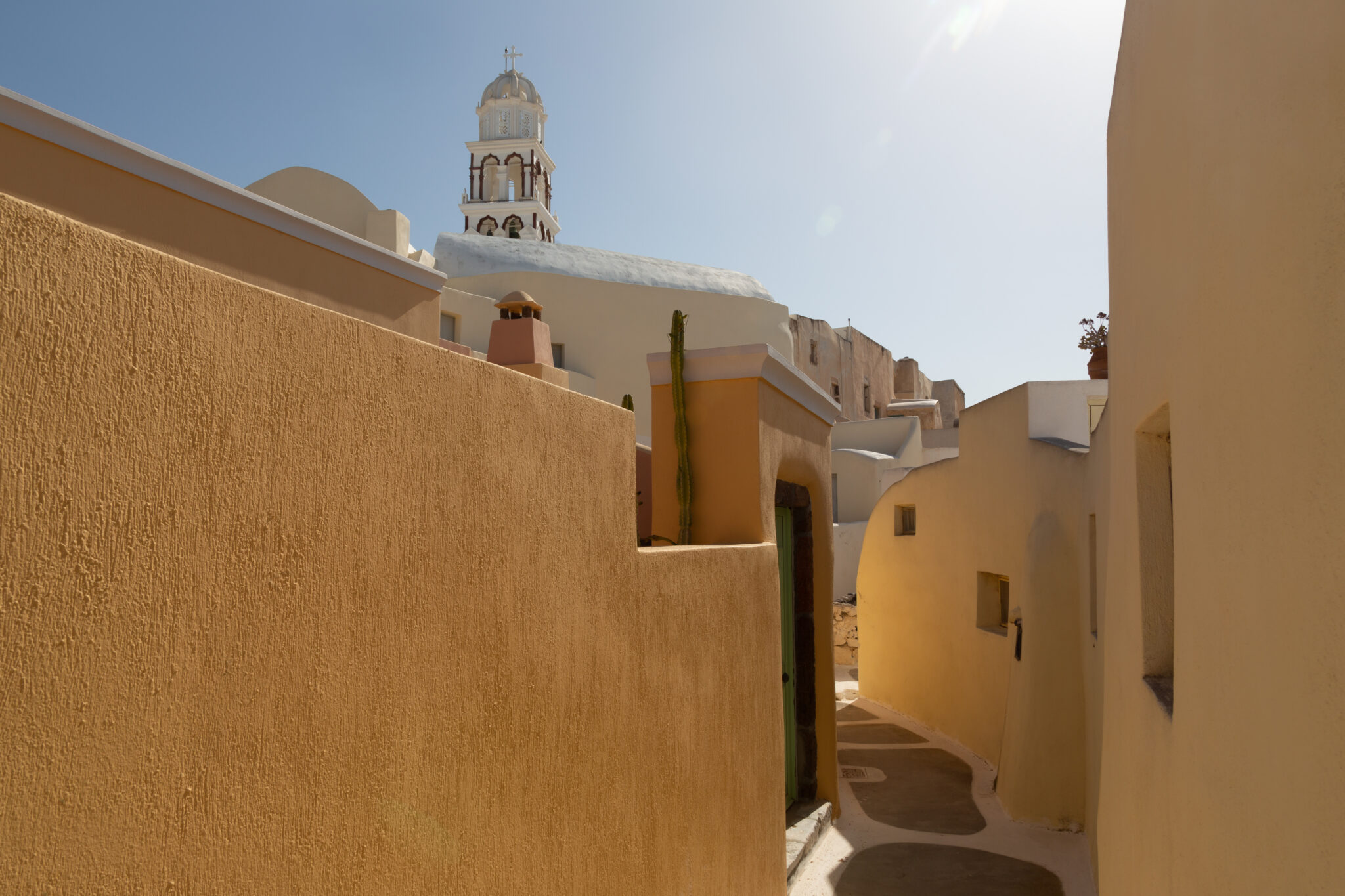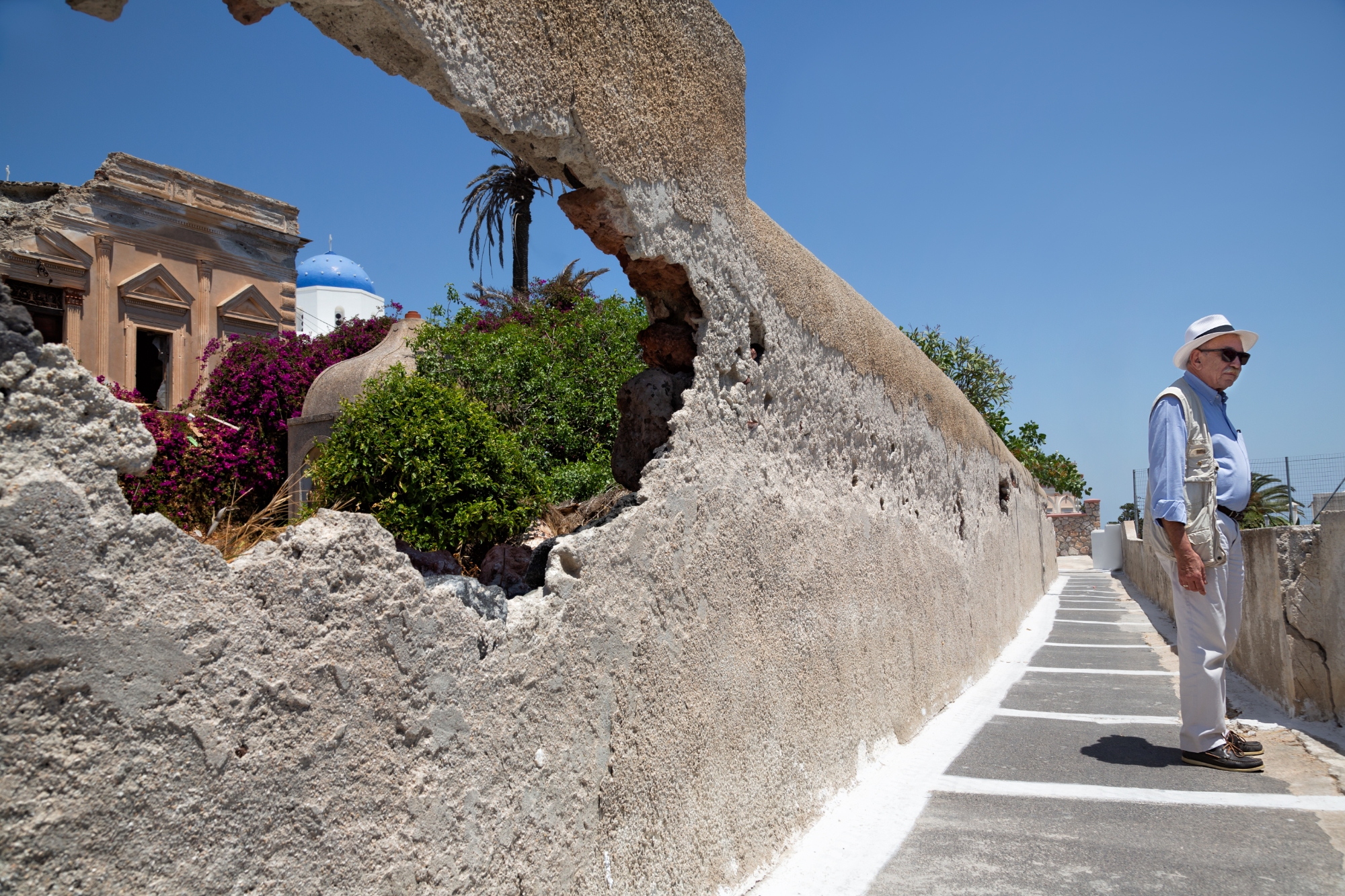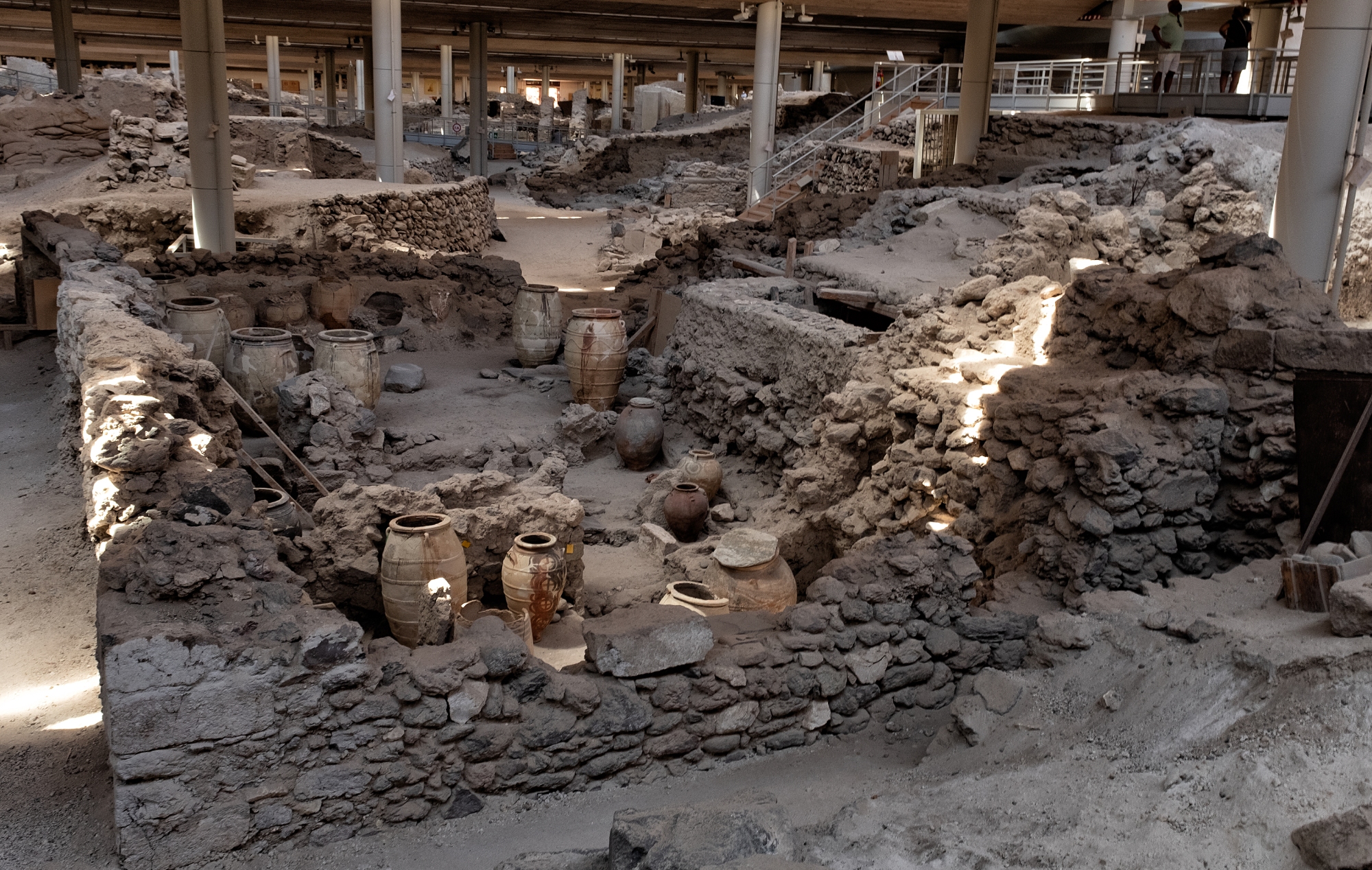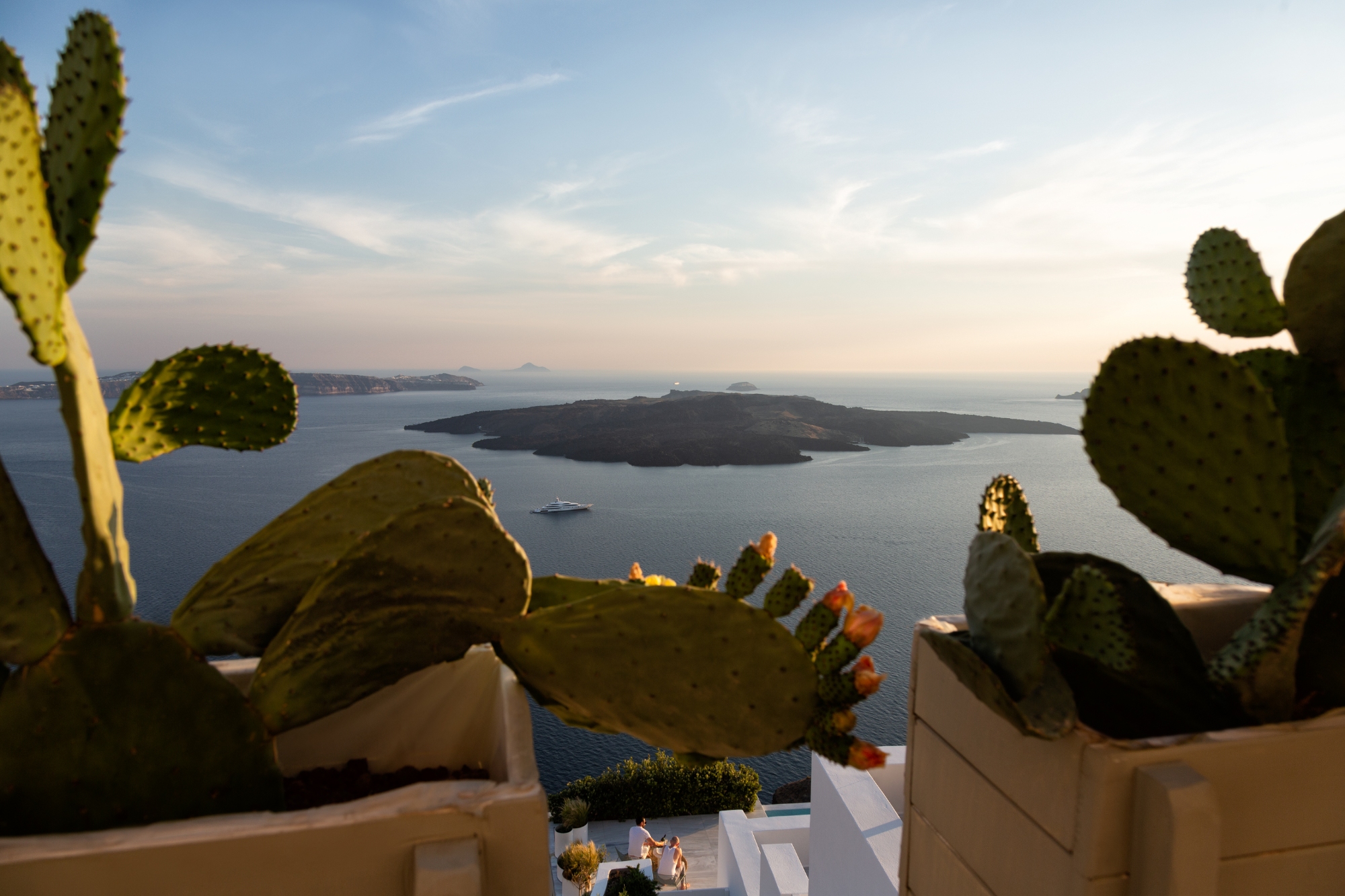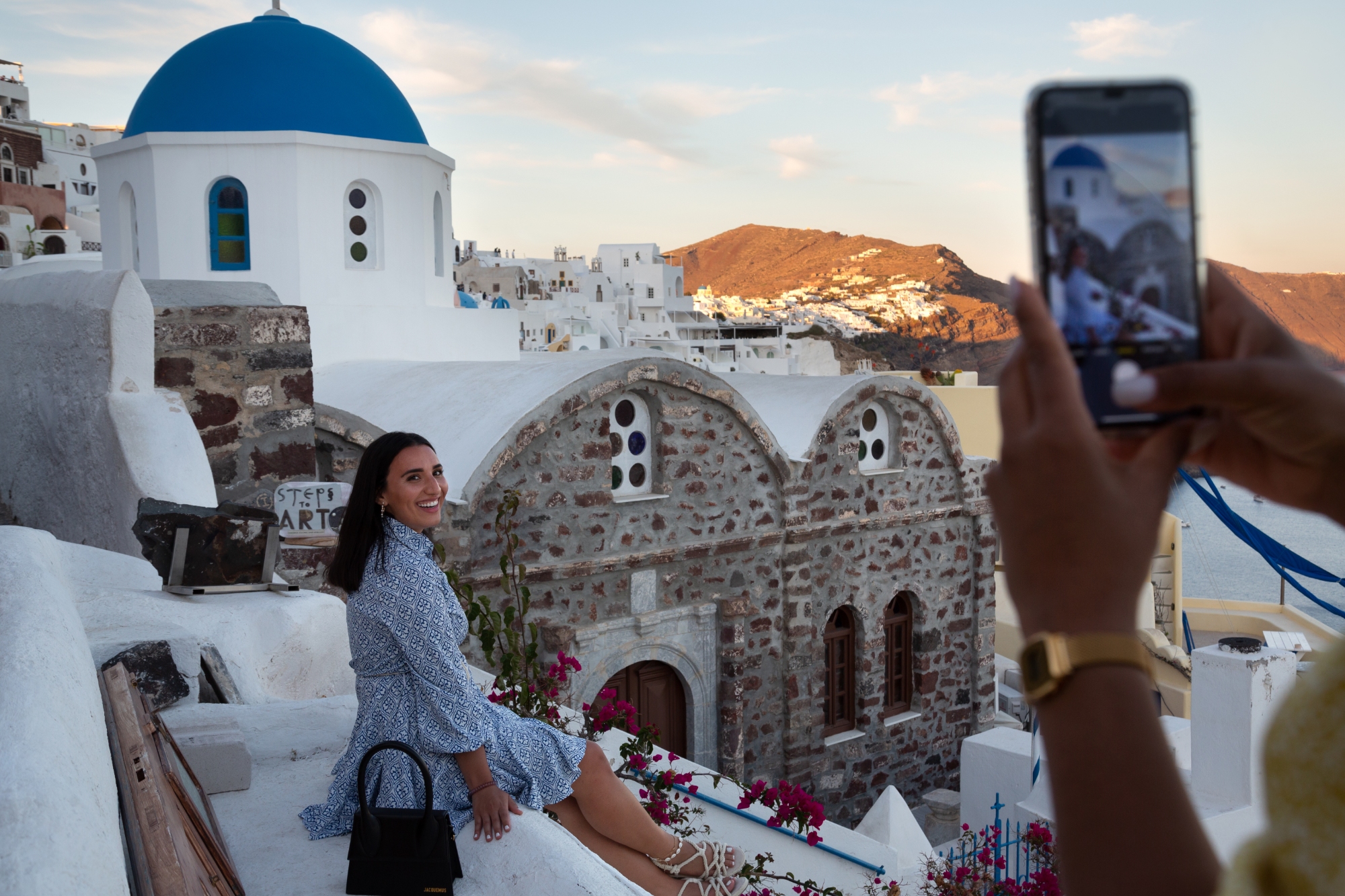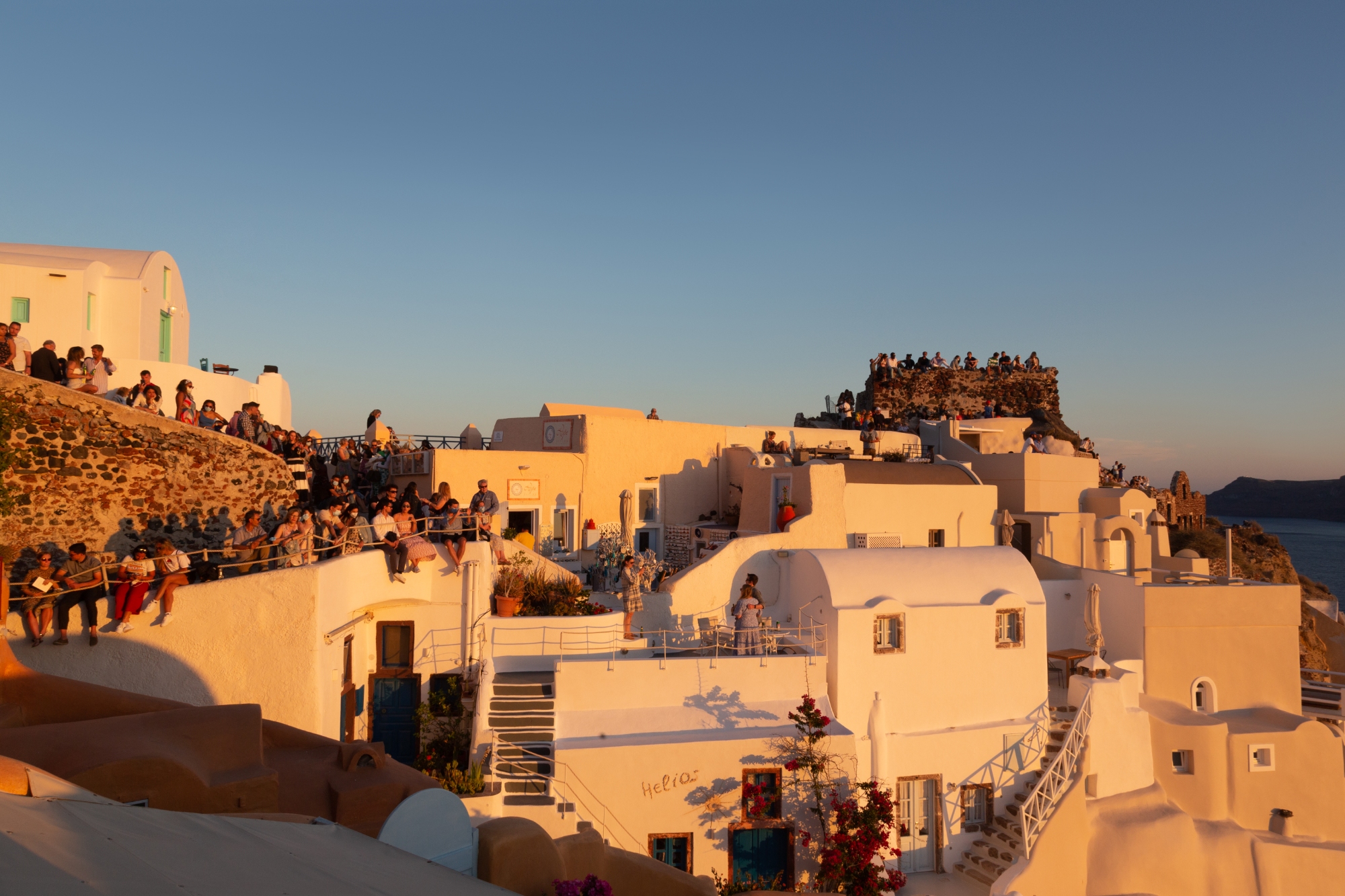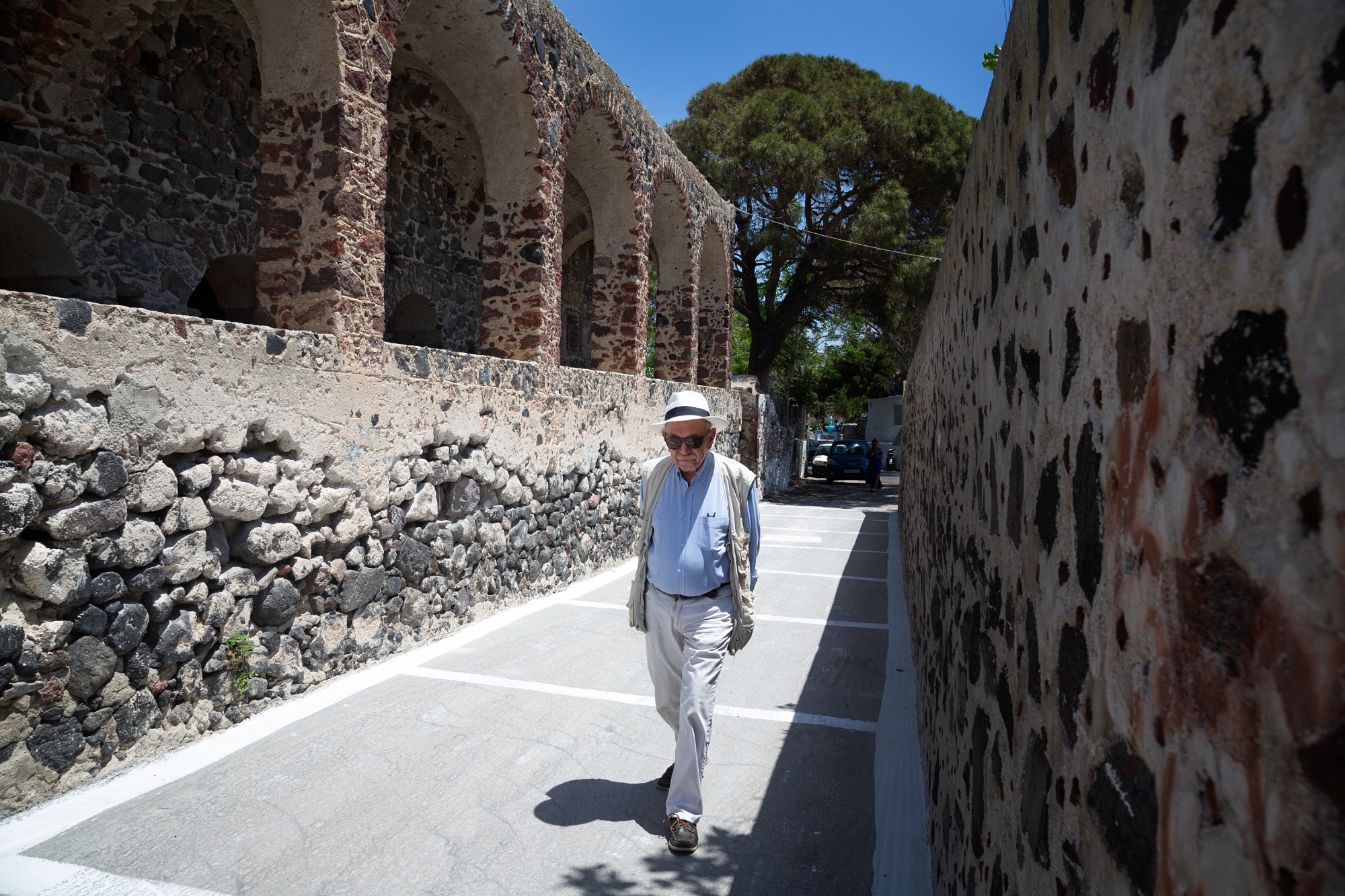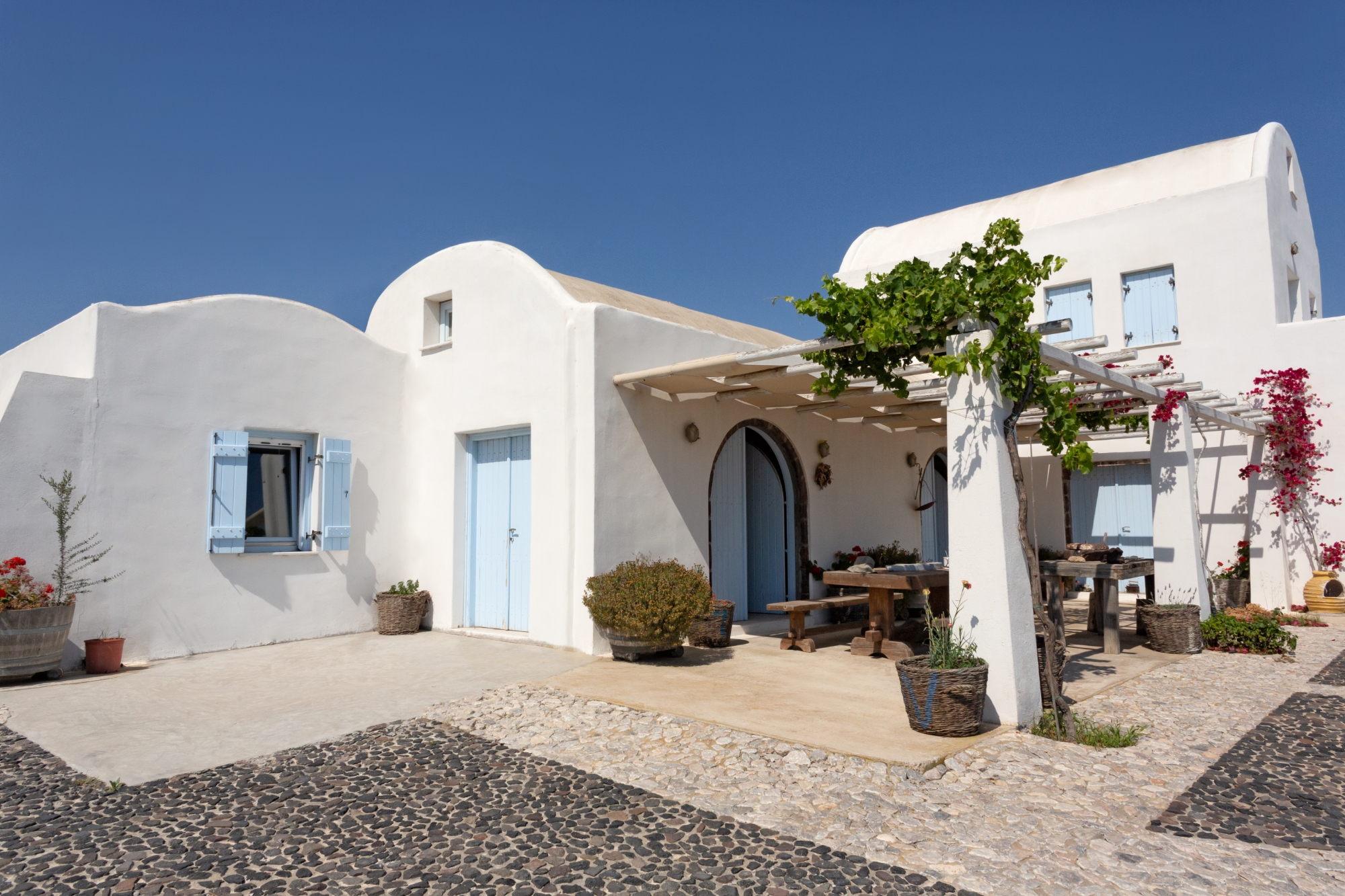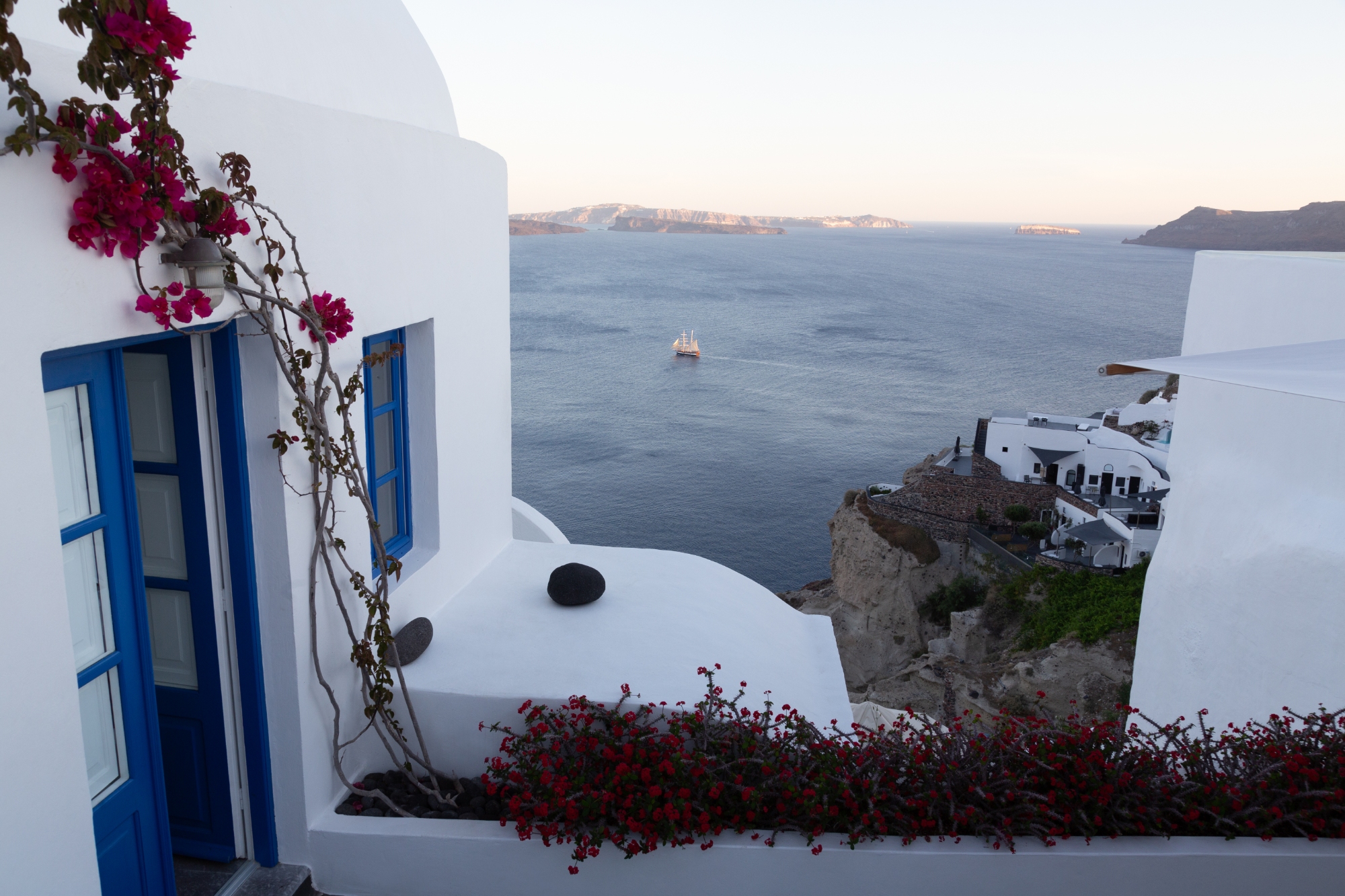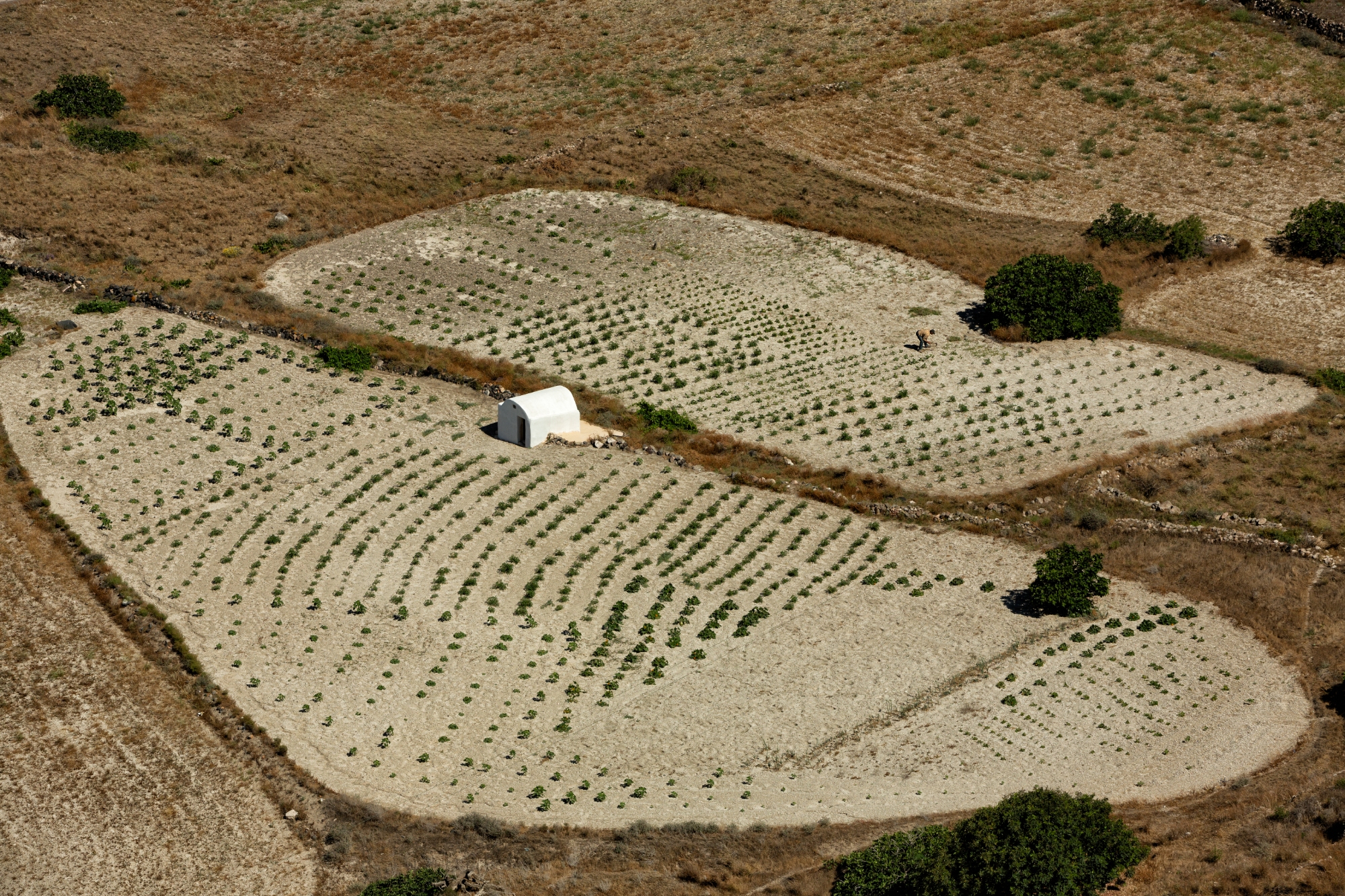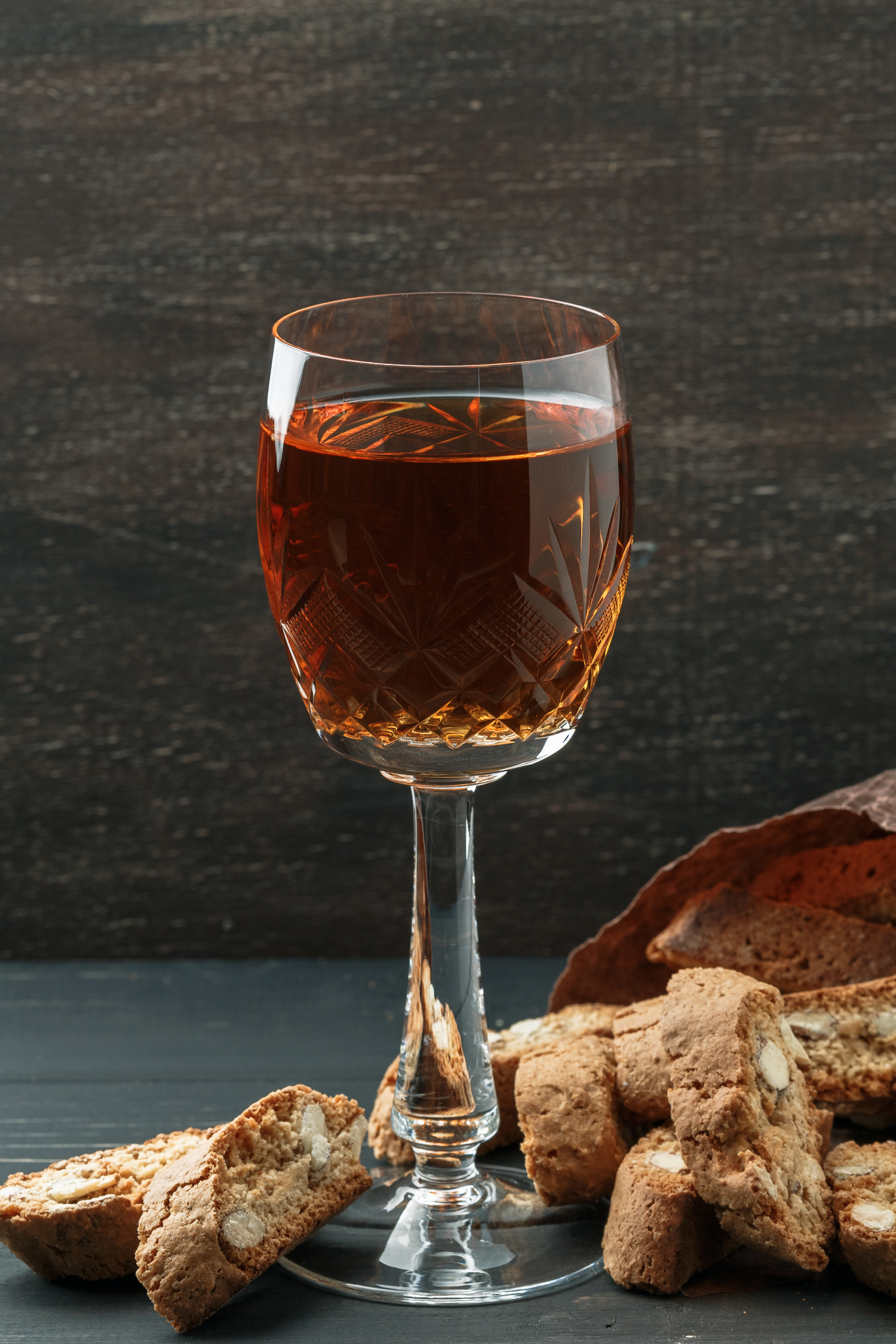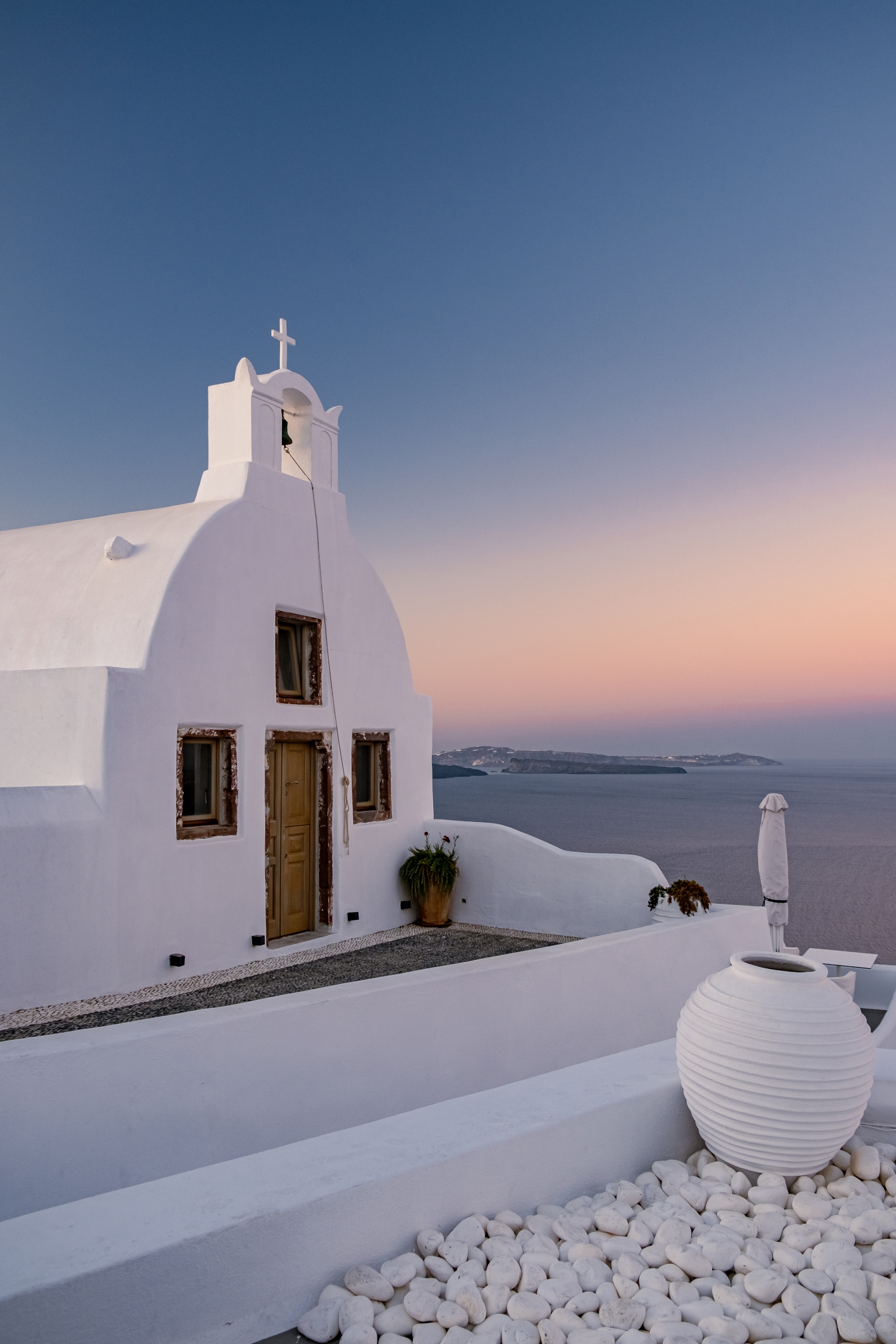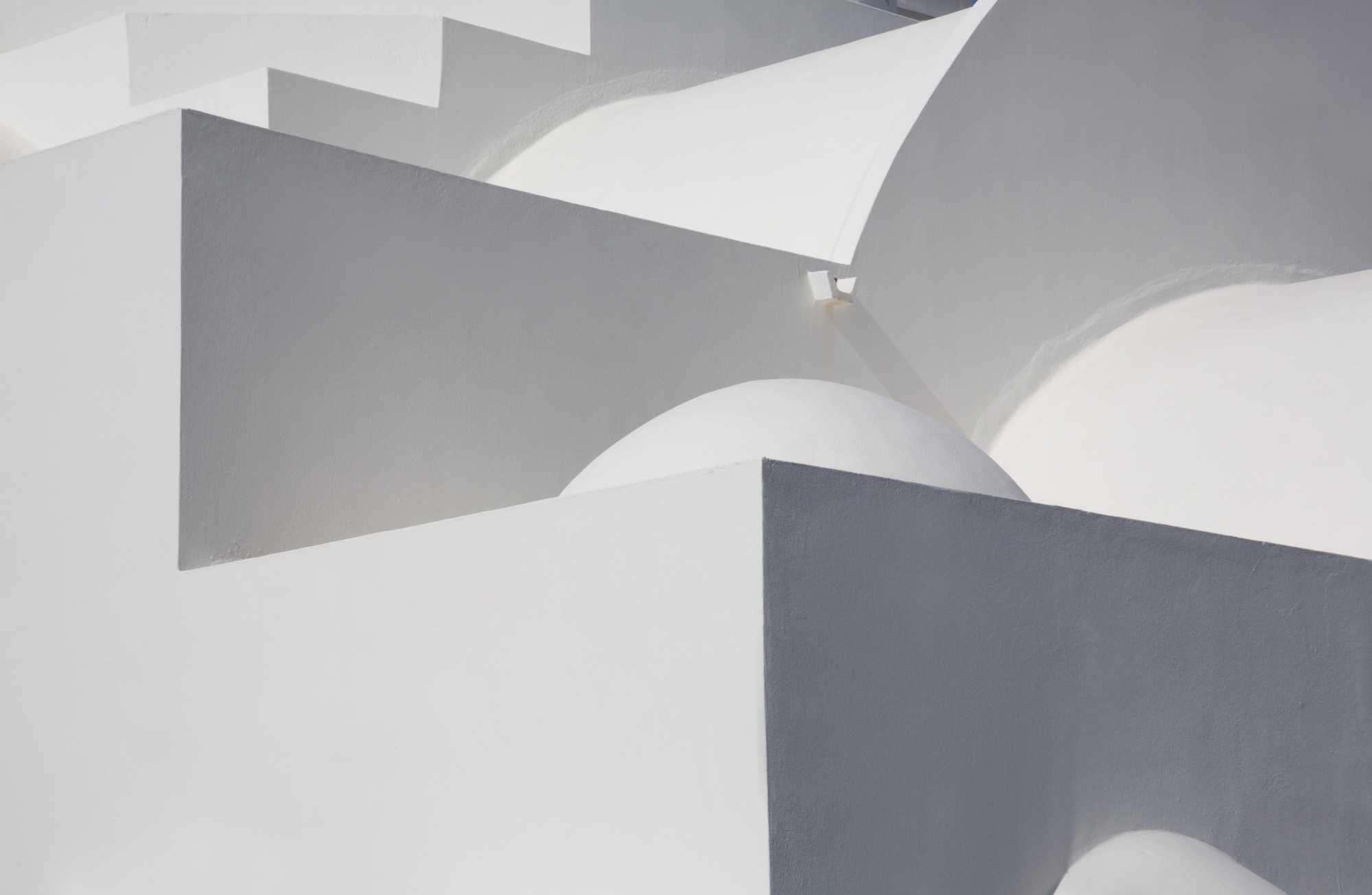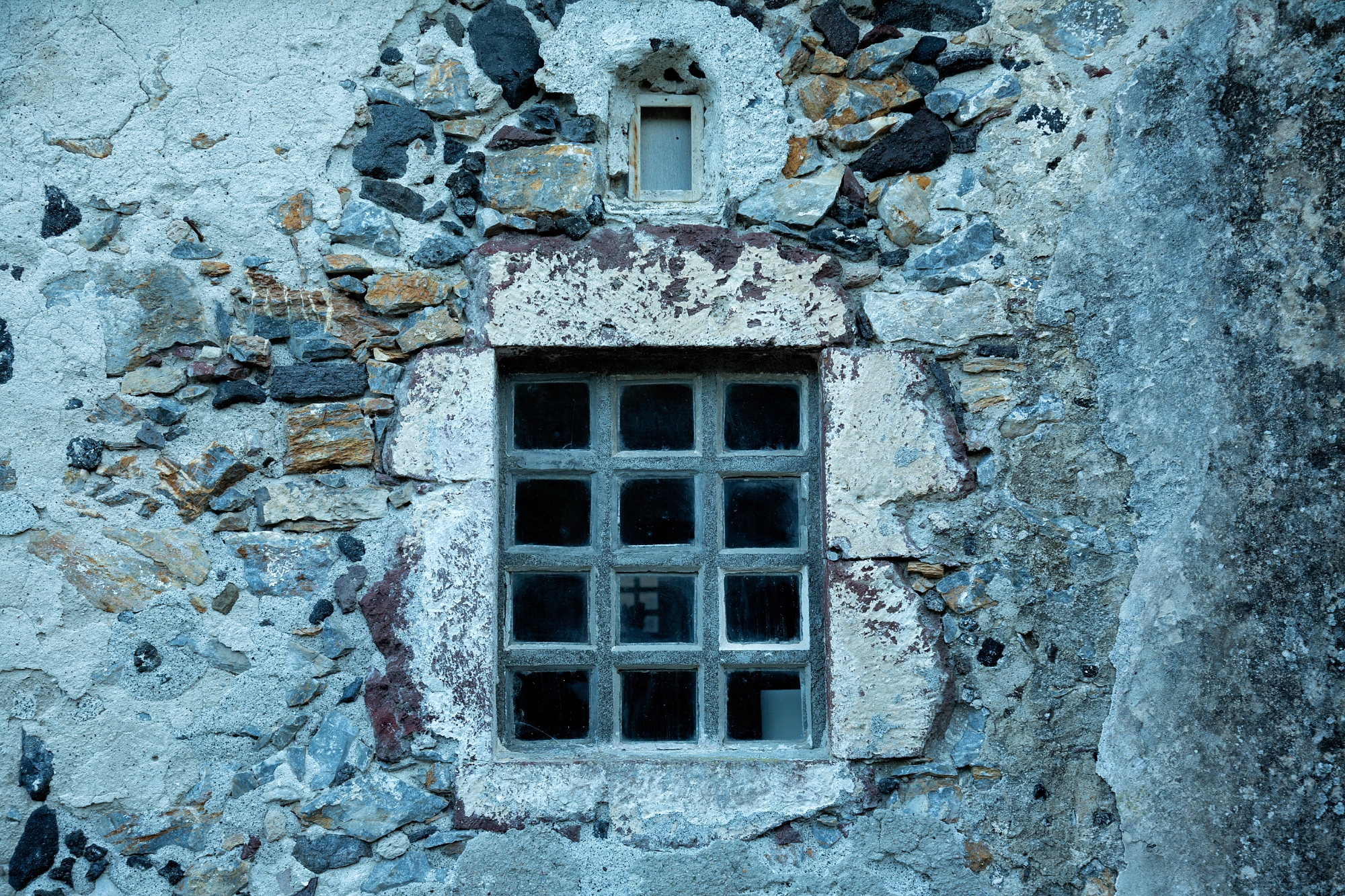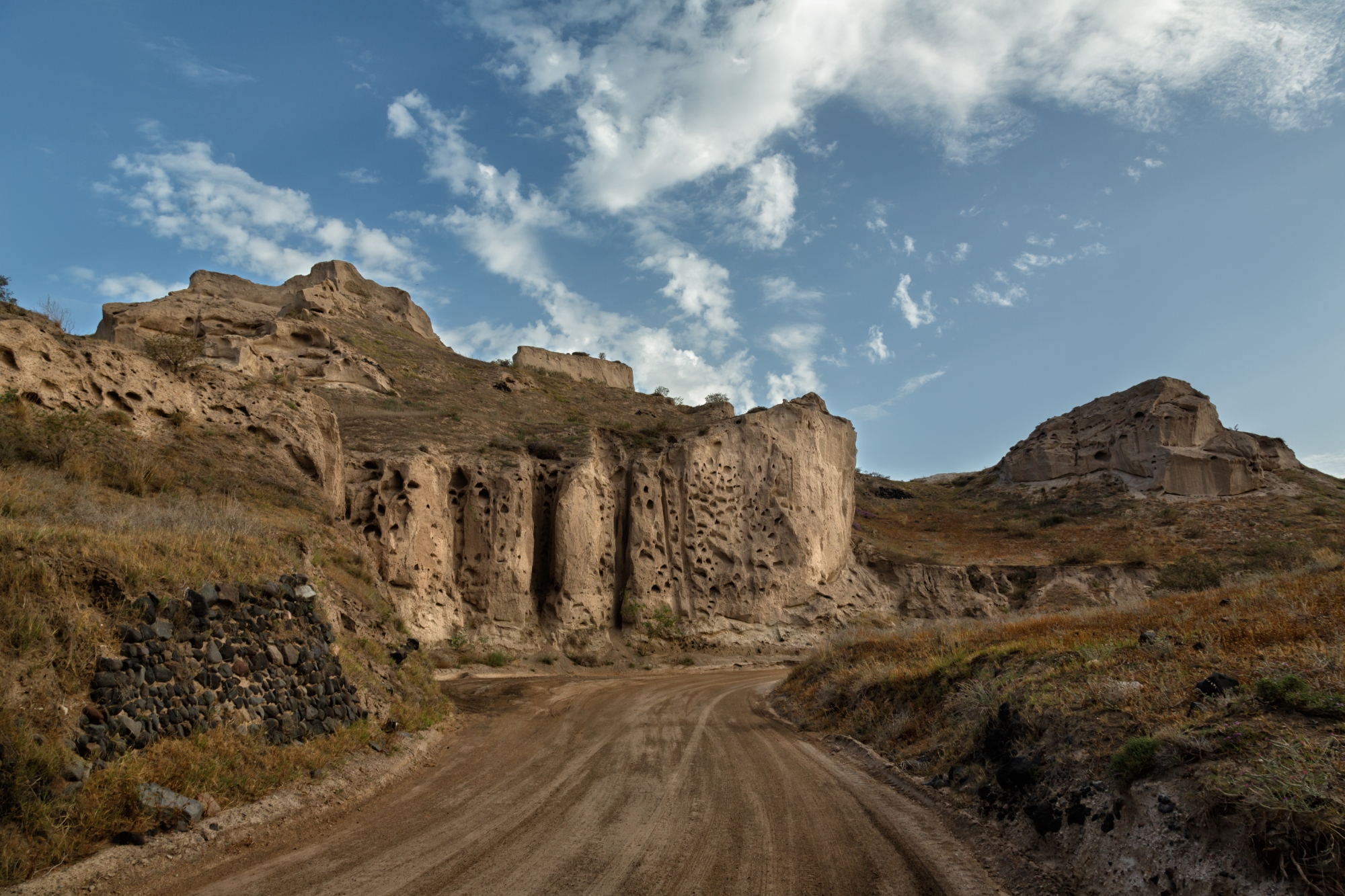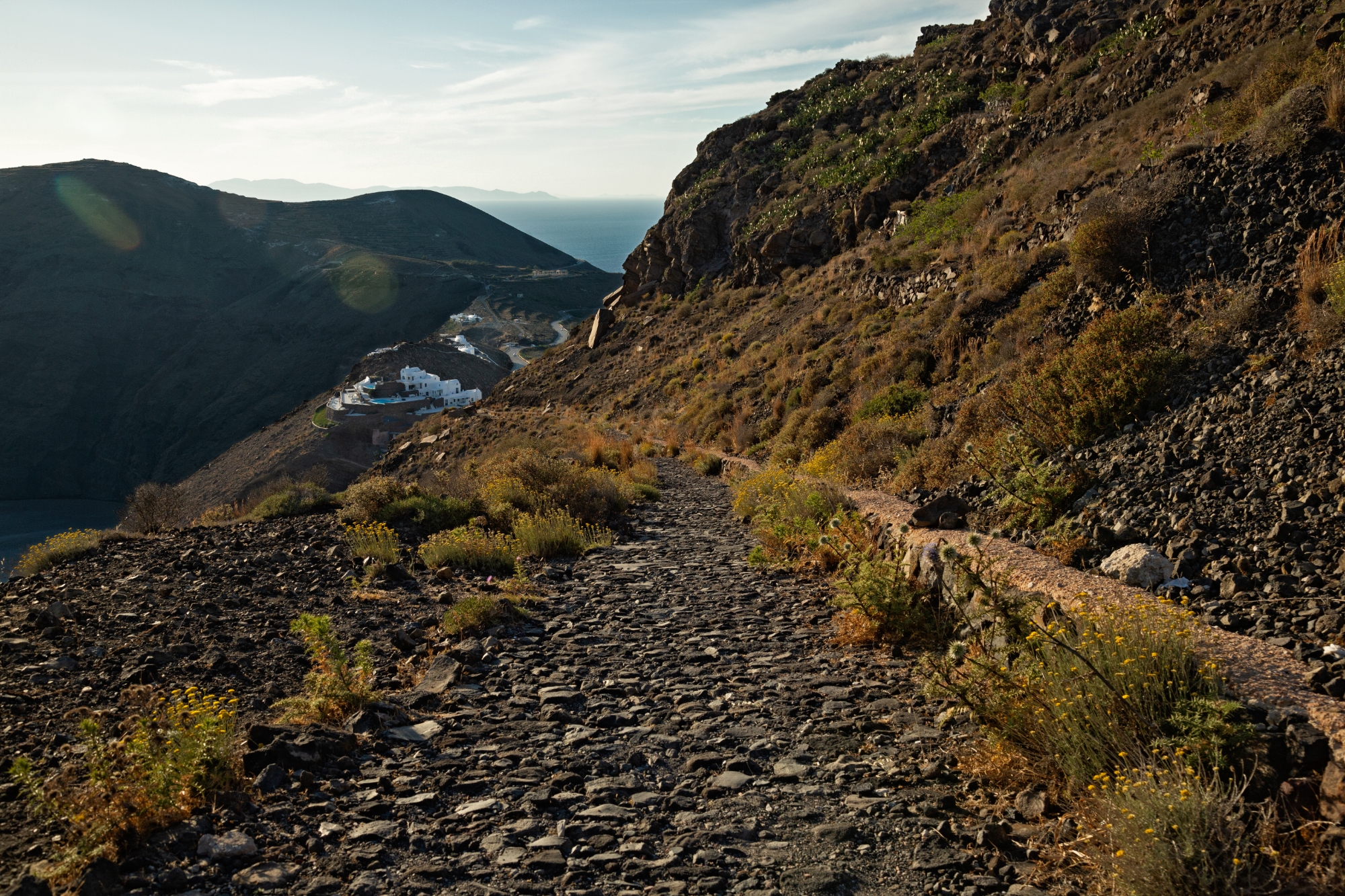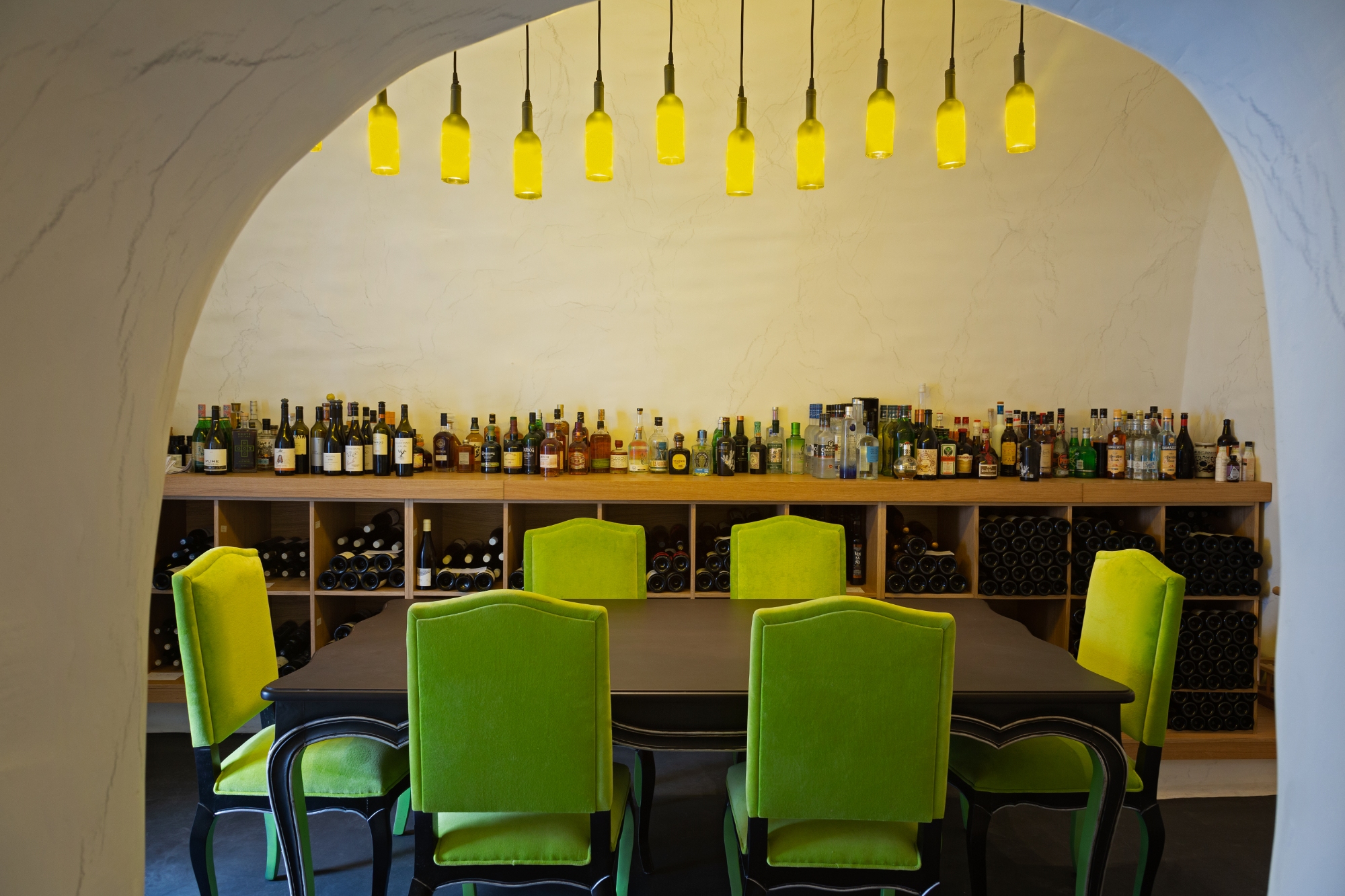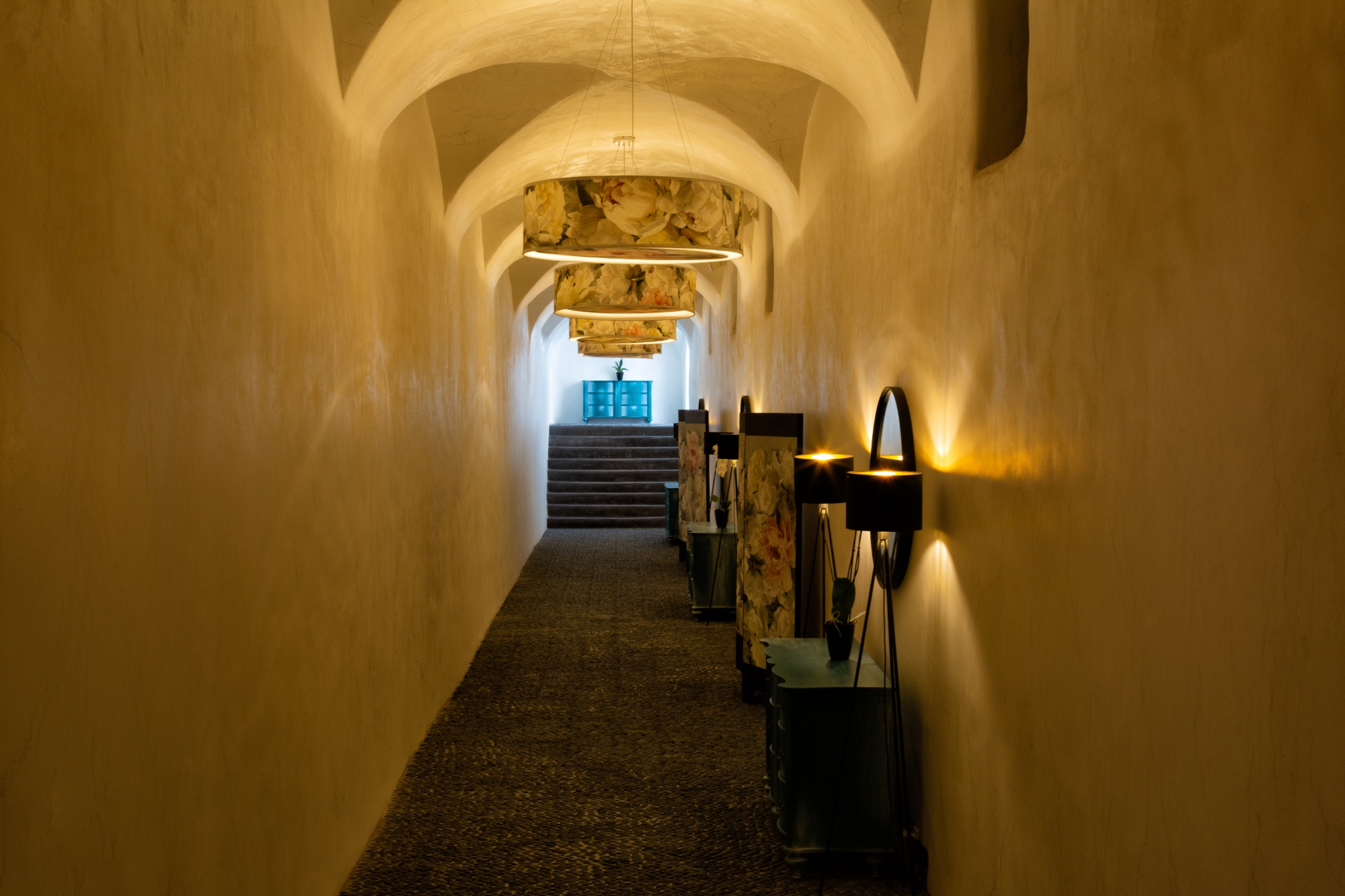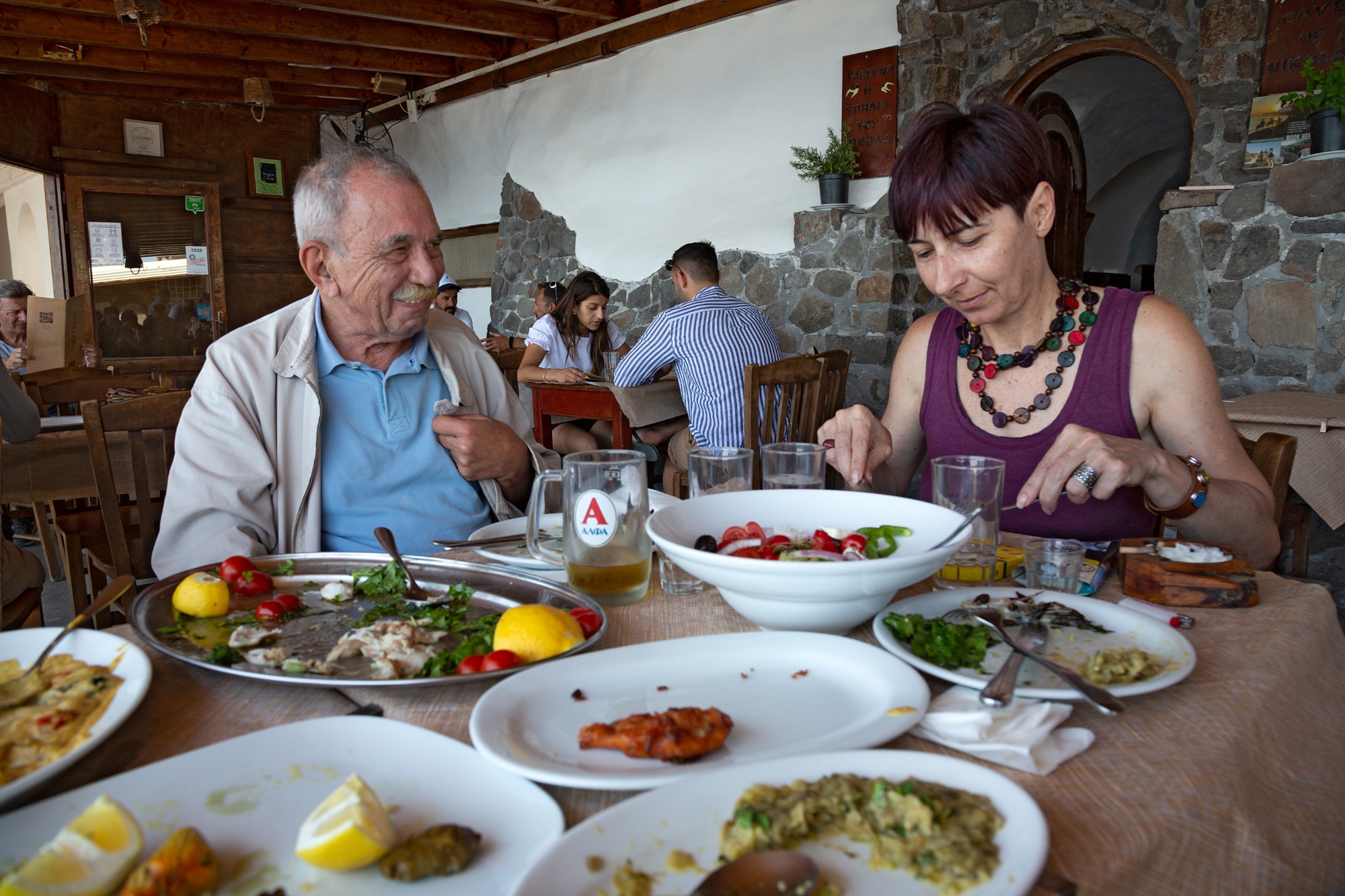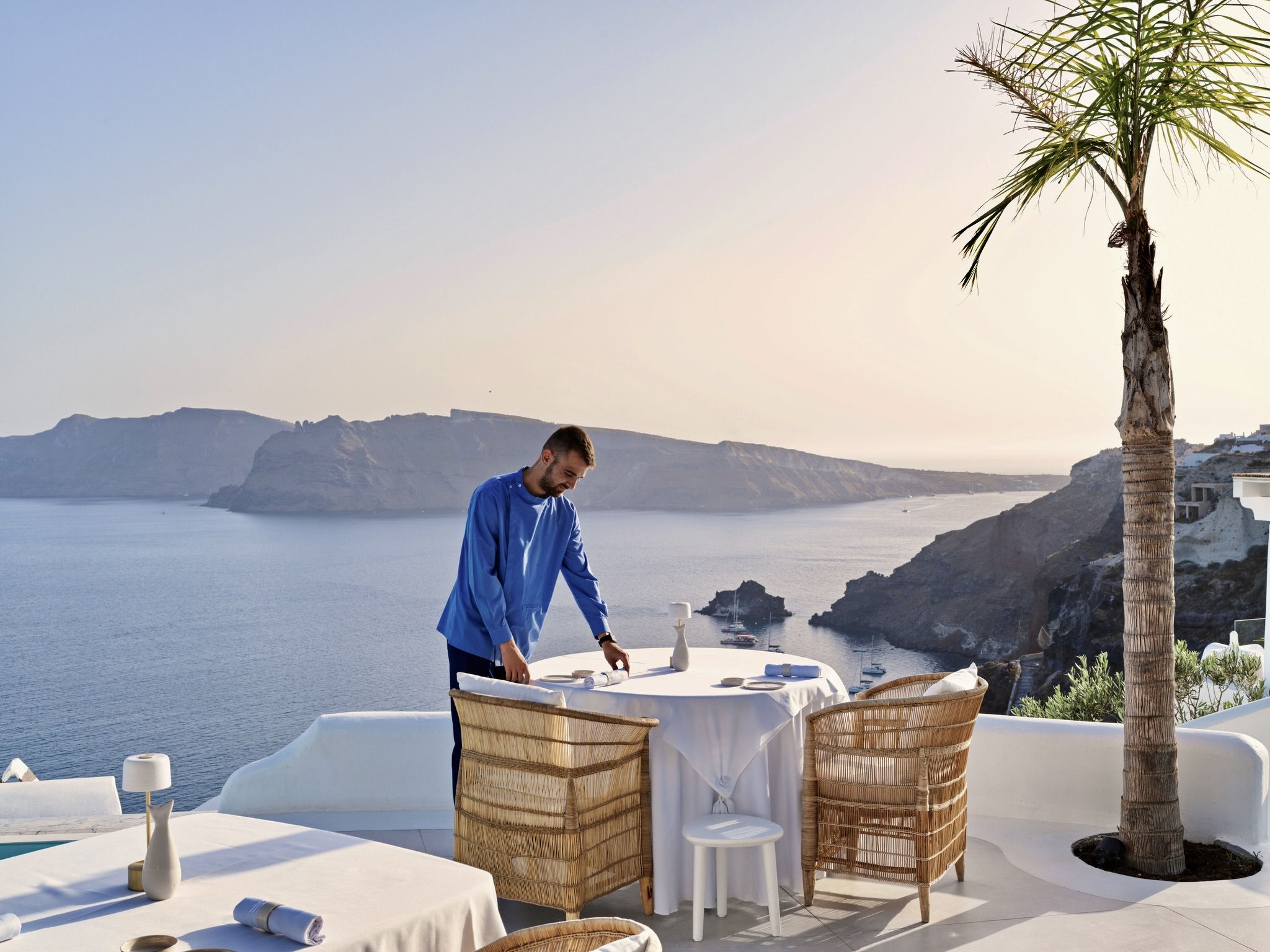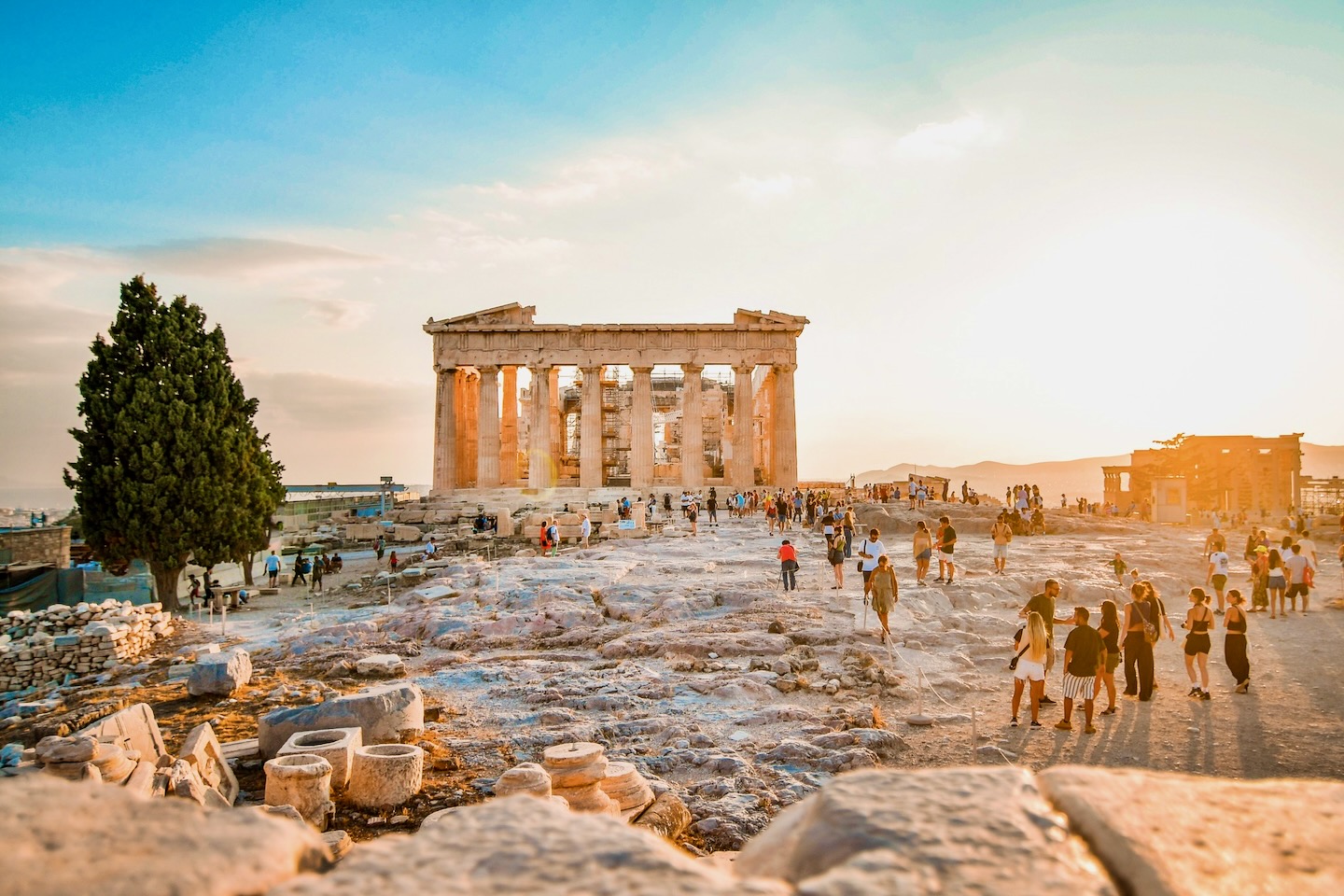Even the most experienced traveller gets confused when dealing with destinations offering an unprecedented variety of choices. And Santorini may be relatively small in size (76,19 m²) but the information overload about it makes it hard to set a course.
However, travel writing has its great moments, and one of them was when we were lucky enough to travel to the famous Cycladic island in fine company. George Hatzigiannakis came with us from Athens to his second home, Santorini, and after recommending we all stay in Pyrgos, the village that was the last location of “Selene” while it was still in his hands, guided us around his favourite spots on the island like a local, going off the beaten tourist track.
With Pyrgos as our base
Pyrgos, at the heart of the island, is a good, alternative choice for staying in Santorini, so long as it’s not your biggest dream to go to sleep and wake up looking at the Caldera. It’s almost equal distance from the North and the South of the island, built high – higher than any other settlement in Santorini – overlooking both land and sea, and, as Hatzigiannakis informed us, it’s probably one of the last villages on the island in terms of tourist development, though, nowadays you’ll find more than 80 accommodation options here, including hotels, rooms to let, and even houses to rent.
Indeed, a stroll around the old part of the village that has already been declared a protected settlement is indicative of the village’s new approach to tourists. However, the stroll is also very interesting, as the narrow alleys reveal nice buildings on each side, most of them built closely together – that’s how island fortress settlements are – while all alleys seem to lead to the top, to Kasteli Castle, and even higher up to the village’s highest point where the church of the Presentation of Virgin Mary (Eisodia tis Theotokou) is located, while the Theotokaki, one of the oldest (10th century AD) churches on the island that has its festival on the 15th of August, is also nearby.
Pyrgos is a picturesque village, like the other, less popular ones, we visited that maintain their colour and architecture: Megalochori with the prettiest square in Santorini, Emporeio with the tallest bell tower on the island, at the church of Virgin Mary Mesani (Palia Panagia), or Messaria with the old factories and mansions – some restored and some half in ruins after the earthquake of ’56 when they were permanently abandoned.
Also, yposkafa, the old cave-like houses one finds scattered around here are very beautiful, they are long and narrow and don’t have foundations, and are either wholly or partly carved into the earth of Santorini and they have vaulted ceilings. They were wisely built at this harsh land, to keep the houses warm in the winter and the cool in the summer. If you’re lucky and one of the residents opens their door to let you in, you’ll immediately feel their unique energy. It’s not a small thing living in the ground.
Most definitely Akrotiri
The prehistoric settlement that the excavations in Akrotiri revealed was also wisely built. Visiting the now covered and enclosed archaeological site is a must, and you’ll learn everything about the excavations and about the site you’re on; it was first inhabited by people in the Late Neolithic Times, around 4.500 BC, while in the 18th century BC it had become a city. Its location was ideal for safe mooring, as it was protected by the north winds, and the ground’s morphology was suited for agriculture. It’s a well-known secret after all that the fava grown in Akrotiri and Emporeio is the tastiest.
The excavations cover around 14 acres and only a small part of the settlement has been revealed. Additional interesting information is that the area was densely built, and the buildings had multiple storeys with detailed frescoes, organised warehouses, artisan workshops, great urban planning with streets, squares and a sewage system, that passed under the cobbled streets and was directly connected with the houses.
“This last piece of information is quite something, if we consider that modern day Santorini still has issues with the sewage system,” Hatzigiannakis notes sarcastically. And of course, it’s not just Santorini that has sewage issues, but the majority of the islands in Greece, and maybe parts of the mainland too, we would add. But that’s a whole other story.
Sunset both ways
The first day we arrive on the island, Hatzigiannakis tells us that we need to go bit further down, to the Lighthouse, to see the sunset. And we do. Looking at our watches in case we miss the grand Santorinian event, we reach the Lighthouse of Akrotiri, which was built in 1892 by the French company ‘La Société Collas et Michel’, has a lamp height of 100 metres and nowadays is fully automated, giving a white rotary flash every 10 seconds. We didn’t stay long enough to see it. Like so many others around us – most of them were French, in the beginning of June when we took this trip – we took a seat on the surrounding rocks or between the pine trees in front of the canteen at this alternative sunset spot.
Alternative but not unknown. I’m sure that in a few years’ time this spot will gather as many people as Oia does – contrary to the memory Hatzigiannakis shares with us from the past.
Yet, there are still a few spots overlooking the Caldera that don’t draw such crowds. One of them is the small church of Profitis Ilias in Imerovigli, at an extremely high and narrow spot with a view of the sea on both sides. It’s not easy to get to by car, since the road is a dirt road after a point, but also because there is another little church on the way, that of Agios Markos, and it’s a particularly popular one for weddings and other ceremonies, and so, there usually is a lot of traffic to get through.
Those who enjoy the views from Profitis Ilias, and from other secluded spots of the Caldera are the hikers. The easiest trail, one that you can go on with your children, starts at Fira, passes through the neighbouring Firostefani, with which Fira have now merged, and reaches Imerovigli. The same trail however reaches Oia – but the second part of this trail, even though its enjoyable, is definitely more challenging.
But this concerns hikers. The rest of us reach Oia by car, in the evening, repeating in our head three or more times if needed the mantra “I’ll find a spot to park”. Oia is exactly what you imagine. The window display of Santorini: shiny, beautiful, neat, expensive and crowded to excess at sunset. But even so, its beauty is breath-taking, indisputable. Hatzigiannakis’ love for Santorini began in Oia, when a room, a mattress and a window with a view were enough to be happy until next summer, on the same island, the same room and the same mattress. The view, of course, from that window has changed a lot since the mid ‘70s and the early ‘80s when the old gang spent the summers in Oia.
A gang that came to stay
The gang grew, came, returned and eventually settled on the island; it worked and is still here, despite all the new, mainly white, costumes that island wears. And here it comes, today, to show us around and helps us discover the modern version of the island that was destined to become one of the most famous islands in the world.
Behind Oia, on the other side of the Caldera, there is another densely built village, Finikia, and you need to be strong to walk and stay there, since you leave the car at the entrance of the village and do everything else with your two hands and legs – just imagine how expensive building here must be, when all the building materials and tools are still carried by men and donkeys. The working / farming class of the island used to live in Finikia, which is, as we said, behind Oia, and also in Vourvoulos, that is behind Fira. And in Emporeio too most of the people were farmers (and in way back in the past serfs) and some of them fishermen.
Generally, the area at the back of the island, with the easy access to the sea, that overlooks Anafi island, is the area with the most beaches, the brand new airport of Fraport in Monolithos, and the smaller bays where the professional fishermen of Santorini (135 in number; it’s a profession that has thrived on the island in the past years due to tourism), used to be a huge field filled with vines and vegetable gardens with all the summer vegetables that have flourished here: fava, cherry tomatoes, aubergines, courgettes. Today, of course, climbing to ancient Thera with the stunning view of Kamari on the one side and Perissa on the other, you’ll see more buildings than fields. And the same is true in the mills of Gavrilos in the area of Emporeio, where Hatzigiannakis took us to see the view, like he used to. On the one side you have Perivolos and on the other Vlychada, and both new and old buildings are scattered among the vineyards in a way that is consistent to the destiny of this land – a land that comes with the constant need to dominate nature, a nature, in this case, that is extremely powerful and occasionally unpredictable.
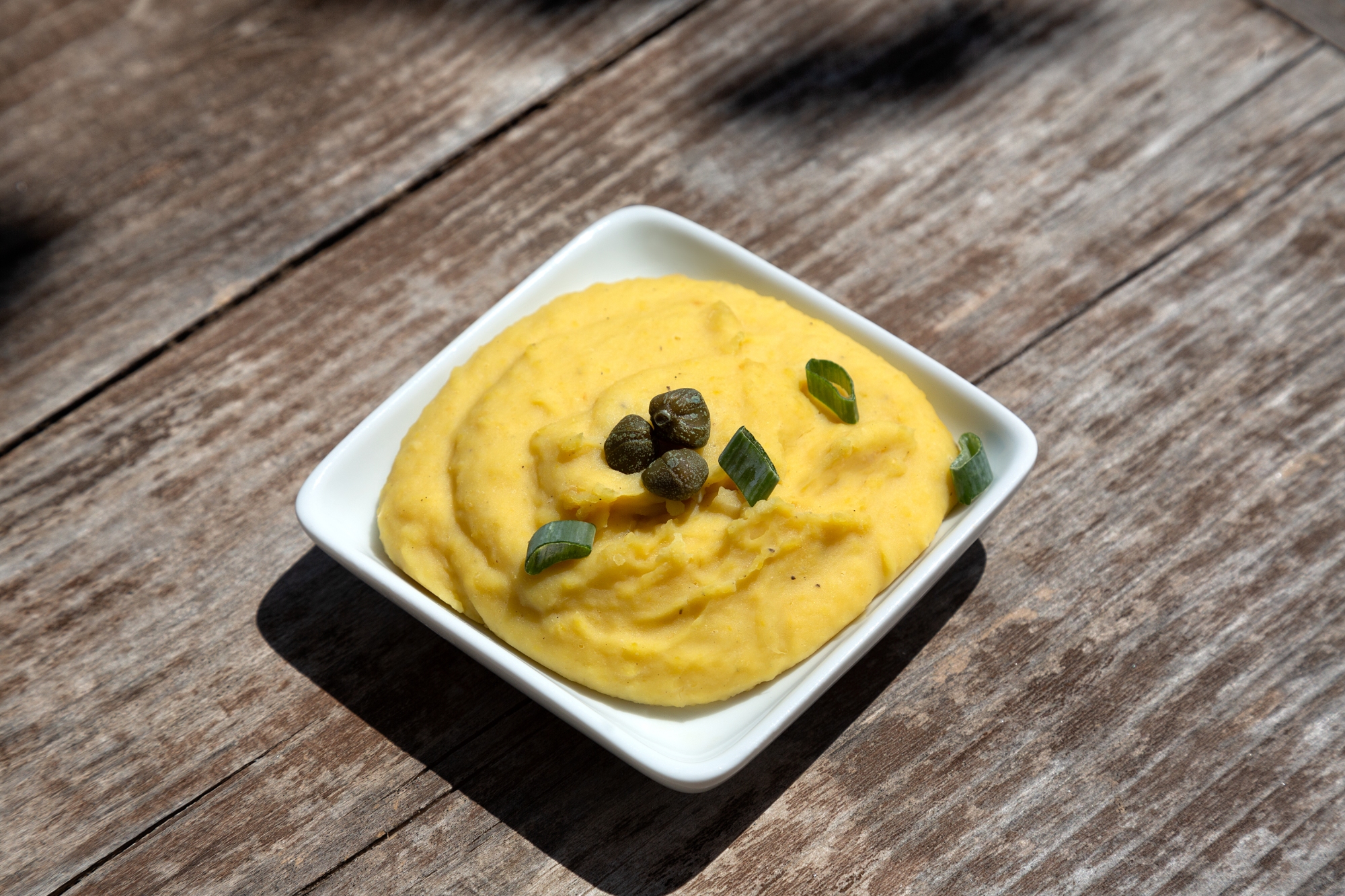
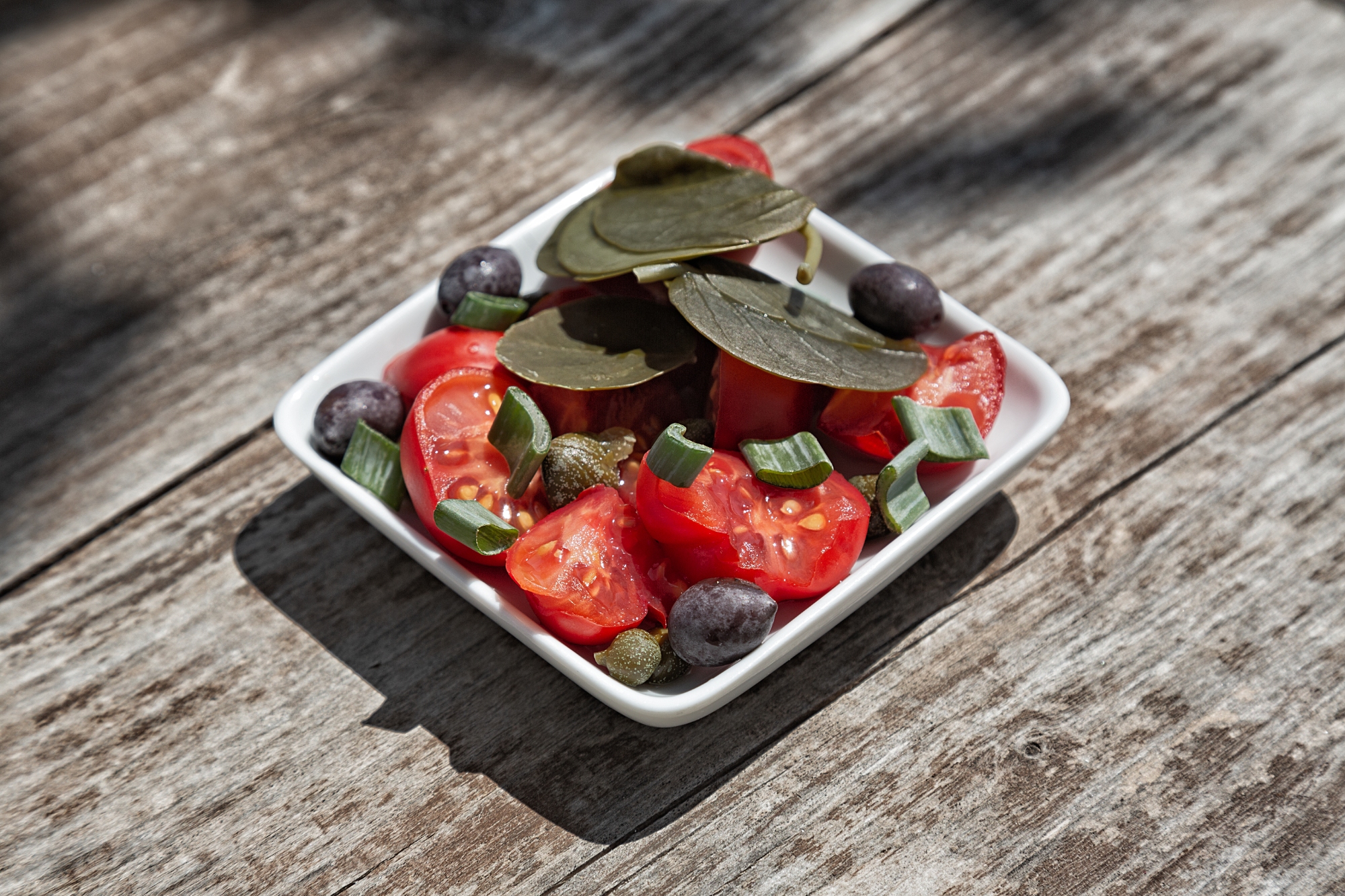
Wine and tomato stories
Another interesting story says that already in the 16th century, according to maps and travelogues of the time, and maybe even earlier than that, Santorini exported big quantities of the sweet Vinsanto wine, that is produced on the island from “sundried” grapes of many varieties, with the most dominant one being Assyrtiko. This was the main commercial activity of the locals, which in the beginning of the 20th century was big but also limited to Russia, Ukraine and Romania where Vinsanto was the official wine of the Holy Communion.
But everything changed with the Russian revolution of 1917 and the persecution of religion that brought an abrupt ending to the demand for “holy wine”. And what could the people of Santorini do? They started pulling out the vines and planting cherry tomatoes that were already becoming popular in the Greek market. In fact, it wasn’t long before, as we read in a dissertation with the title “Cherry tomatoes from Santorini and the Bolsheviks” by local Dimitris Prassos, “the tomato paste ‘of the Thira kind’ was officially established and the big merchants of Pireaus would wait for the boats from Santorini to see what quantities they brought and then give a price that would then be the highest price to be given to the tomato paste ‘of the Argos kind’ or to products from other areas of the country”.
In the same dissertation we also read that “the great demand quickly created the need to industrialise the production line” and “in 1923 the first processing and canning factory was founded. In fact, at one time there were nine factories operating in Santorini and in 1949 the production of fresh product reached 7.000.000 οkas, that is around 9.000 tonnes”. In 1950, the factory of the Union of Santorini Cooperatives (santowines.gr) was established which is now the only one still in operation, even if only for a few days per year. A visit to the Tomato Industrial Museum, D. Nomikos in Vlychada (santoriniartsfactory.gr) is very enlightening regarding everything we’ve discussed so far, while among the exhibits you’ll also find processing machines from 1890, old manuscripts, the first labels, as well as audio-visual material with testimonies of people who worked at the factory.
Past and present
This activity also ended in the early morning hours of July 9, 1956 when an earthquake of 7.8 points on the Richter scale took place near Amorgos island and changed the course of the Santorini’s history once again. We’ve already said it: after this event, a large part of the island’s population left the island, and life for those who remained on the island – at least in the first years – was very hard. People had learned to live with the volcano – there are testimonies of older people from Santorini saying that they would use umbrellas to protect themselves from the ashes in the past decades, when a few eruptions took place – but an earthquake was different. Especially this particular one, that has been recorded as one of the strongest earthquakes of the 20th century in Europe, brought total destruction.
But let’s return to today. To the Santorini whose fame has reached all over the world. And that even now, in the beginning of the summer, has European and American visitors (due to COVID-19 tourism from China hasn’t started yet, but it will soon) of all ages exploring and enjoying it. And with them, we toured the villages, made lists of the beaches to go swimming, of the wines to drink, and of the tavernas and restaurants to visit. Hatzigiannakis and the Santorini gang have certainly helped with those lists. Below, instead of a farewell you can find our notes.
NOTEBOOK
Spend a night at the Voreina Gallery Suites in Pyrgos (2286030700, voreinasuites.gr). Spacious suites, with simple design and luxurious amenities with private pools or jacuzzi, and very friendly staff.
Skip the hotel’s breakfast at least once to have treats from the Pyrgos Bakery (2286031062). Try different kinds of fragrant, freshly baked breads, amazing raisin bread and buy militaria pastries to bring home. Melitinia are a small traditional sweet from Santorini, with dough prepared with anthotyro or myzithra cheese, flour, eggs, sugar and natural mastic or vanilla that is “pinched” forty times, as many as the days of Lent, and is puffy and just sweet enough. According to tradition it’s prepared on Holy Tuesday to be eaten on Easter Saturday and the days after Easter.
If you’re staying in Pyrgos there are two spots you need to visit for their stunning view. One is Franco’s Café (2286033957)high up in Kasteli, and the other Penelope’s Ouzeri (2286033192), whose tables have such a great view of the sunset that reservations are required. At the village’s square, also, right on the street, you’ll find the popular Brusco (2286030944) that describes itself as a wine bar, a coffee place and a deli and is all of that at once.
In Messaria apart from strolling around the old mansions, you must visit the welcoming garden of the Cretan café-grocery shop Pentozali (2286037383) for good raki, dakos salad (traditional salad usually containing rusks, grated tomatoes, cheese, olives and capers) omelette with syglino (traditional smoked pork), apaki (another traditional smoked pork cut) and various kinds of graviera cheese. And if you go exploring Megalochori village you need to go to Geromanolis’ tavern (2286082892), where, if you’re lucky, apart from the rest of the menu that includes both meat and fish dishes, you might get a chance to try ofto lamb (a traditional way of preparing roasted lamb), served with the most delicious fries on the island.
At Vlychada bay you’ll wait for the fishermen to bring the day’s fresh catch, straight from their nets, and go to Steki tou Psara for a coffee or tsipouro (traditional pomace raki) (depending on the time) which you’ll enjoy with small fish, fava, tomatokeftedes (fried balls of tomatoes and herbs), and also grilled meat, depending on your mood.
Nearby you’ll find Eros beach that you can reach on an easy to navigate dirt road between high steep rocks that could be described as the Greek version of the Grand Canyon. The scenery is breath-taking, but the sea is paved with rocks and so you need to be careful. There’s also a beach bar here, at the most accessible part of the beach, called Theros for those who prefer a serviced beach.
The Catholic neighborhood in Fira resembles Italy with its cobbled streets, the galleries and the Catholic monasteries, including St. John the Baptist Cathedral, the Catholic Diocese of Thira and the Dominican Convent are all still in use. Other monasteries have been turned into luxury hotels like the gorgeous Katikies Garden (katikies.com) that used to be a monastery. Since last year, this is the home of the new Selene restaurant (2286022249), led this year by awarded chef Ettore Bottrini.
Also, in Fira you can visit the Museum of Prehistoric Thera, (2286023217) and make a reservation for wine and dinner at the relatively new, minimal, Anhydrous Winery (anhydrouswinery.com), that belongs to Avantis Estate and offers food & wine pairings of wines from Santorini and Evia and a degustation menu prepared by chef Giannis Baxevanis.
One of the island’s oldest restaurants, Skala (2286071362), owned by Christos Markozane and Stavros Sigalas, can be found in Oia. “A stable, honest and attractive Skala (it means staircase or ladder in Greek), a landmark since 1984” as the two like saying. For many years, the very good chef from Volos, Iraklis Mazis, is in charge of the menu.
Get your appetite going by walking around Finikia village and then go satisfy it at Krinakitavern (2286071993), where you can also go for breakfast, but don’t forget to order the chicken thigh skewer with sage, red pepper yogurt and baked potato that is cooked to perfection, as well as the ribeye steak from Elassona, matured for 30 days, with grilled cherry tomatoes and spicy aromatic dip. The latter is for two to share and is just what you need if you’ve mostly had fish in the previous days.
Speaking of fish: after you go swimming in the area of Perissa and Perivolos there’s only one destination for food, the restaurant Ta Dichtia (2286082818). Fresh fish, perfectly fried, and an excellent tuna carpaccio or a cuttlefish bulgur, right on the beach for lazy noons and nights on the island.
One thing will bring you to Vourvoulos: the new era of Roza’s (2286024378), now owned by a Georgian woman and a man from Thessaloniki and the result is superb: fried Santorinian katsounia (aka a type of cucumber that grows on Santorini), papalines from Lesvos (marinated sardines), stuffed vine leaves with eel toping and lemon foam are a few of the appetizers you’ll enjoy together with the fresh homemade bread.
Akrotiri has more to offer than the ancient ruins; you can go there to can take the boat to the White beach. The Red beach, at the time of writing, was not open to bathers due to the danger of landslides. Akrotiri is also the home of Nikolas’ Cave (2286082303, nikolascave.gr) where you can eat fresh fish and a lot more. The owner’s grandfather first opened the tavern in 1967 to serve the workers at the excavations of Akrotiri. Since then, the family has been running the now famed tavern, but have also maintained their farming activities. Minas Alefragis, Nikolas’ grandson, who has been running the tavern for the past 17 years, grows on his land all the summer vegetables and also keeps sheep and goats and so, makes his own tasty cheeses.
Spend an evening at the open-air cinema at Kamari (santorinicinema.com), but make sure you’re dressed warm enough as it can get cold, like all of the Cyclades, Santorini is a windy island. Also, for most places on the island, wearing comfortable footwear is a good tip to keep in mind, be they sandals or shoes.
The beaches of Perissa and Perivolos with the black pebbles and the deep crystal-clear waters are ideal whether you like serviced beaches with umbrellas, or whether you prefer to bring your umbrella and provisions. Santorini has many beaches, most of them not that well-known, but all of them equally great. All you need is a desire to explore.
Kostas Konstantinidis’ Heliotopos (heliotopos.net) is located in Imerovigli and there, at the wine bar of the same name, that’s open only at night, you can have white wine and good pizza and talk about the destination everyone loves and whines about but continues to love: Santorini.



